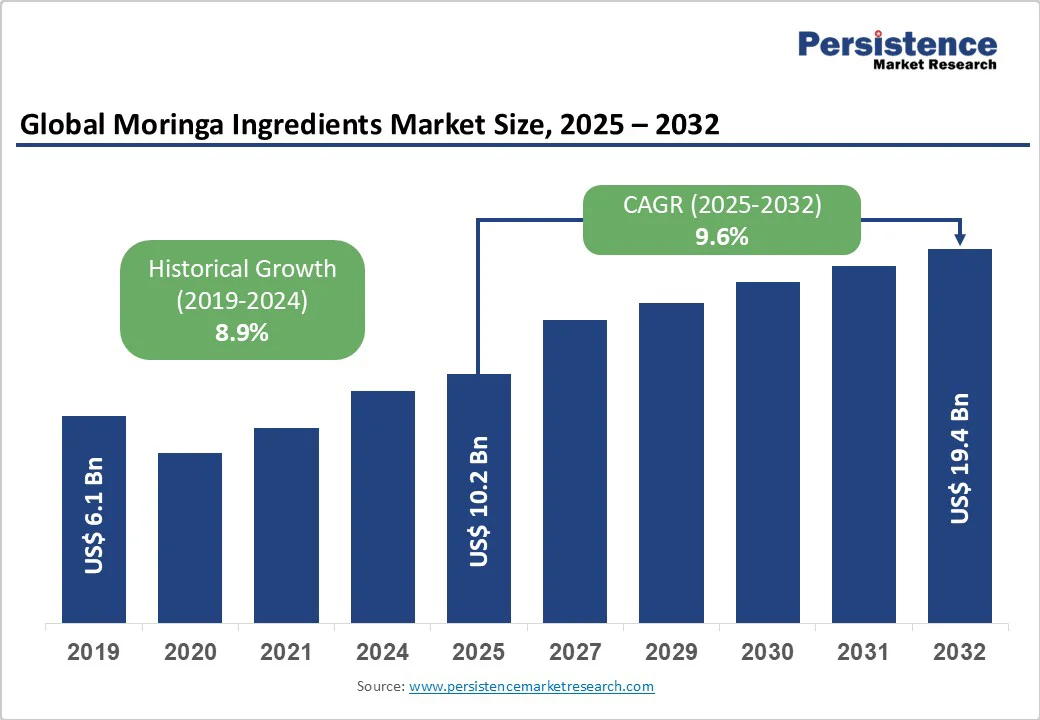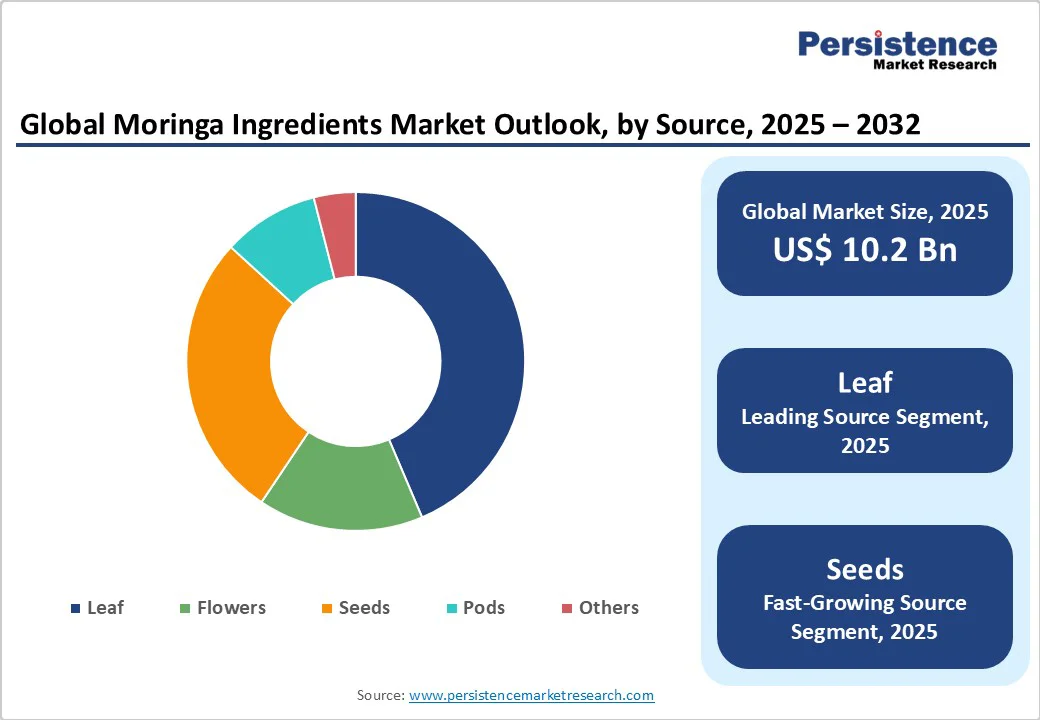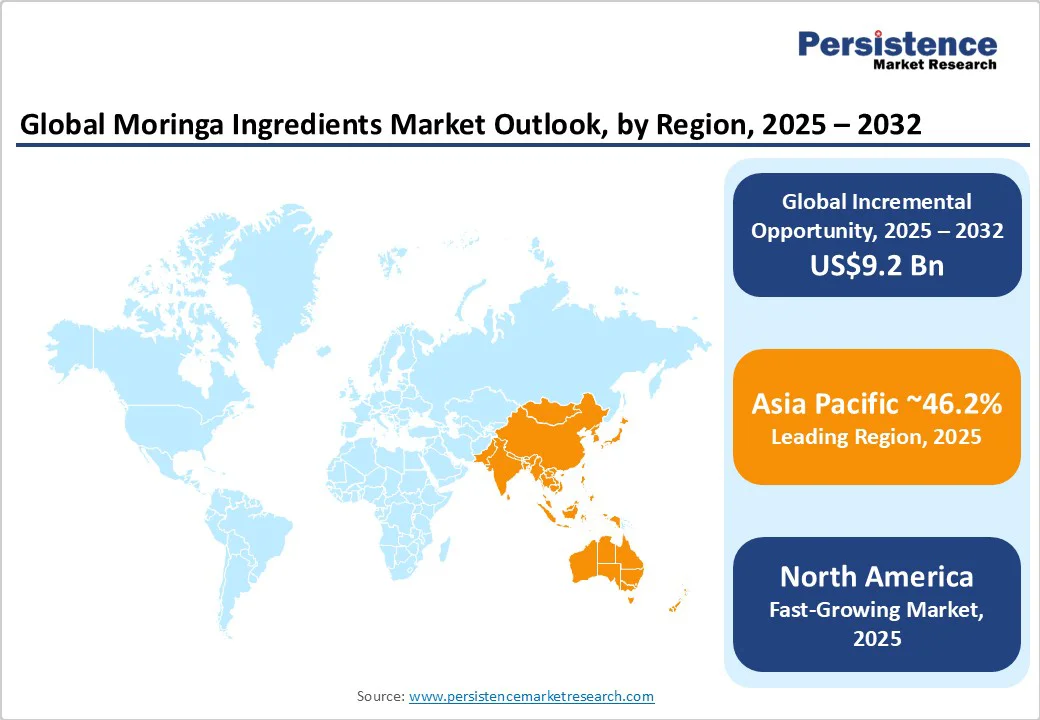ID: PMRREP31380| 198 Pages | 13 Oct 2025 | Format: PDF, Excel, PPT* | Food and Beverages

The global moringa ingredients market size is likely to be valued at US$10.2 Billion in 2025 and is estimated to reach US$19.4 Billion in 2032, growing at a CAGR of 9.6% during the forecast period 2025-2032, driven by rising consumer focus on plant-based nutrition, clean-label products, and natural wellness solutions.
| Key Insights | Details |
|---|---|
|
Moringa Ingredients Market Size (2025E) |
US$10.2 Bn |
|
Market Value Forecast (2032F) |
US$19.4 Bn |
|
Projected Growth (CAGR 2025 to 2032) |
9.6% |
|
Historical Market Growth (CAGR 2019 to 2024) |
8.9% |

The cosmetics industry is now turning to moringa ingredients for their rich nutrient content and skin-improving properties. Moringa seed oil is gaining traction as a natural alternative to synthetic emollients as it is high in oleic acid and antioxidants, which help combat dryness and oxidative stress.
Brands such as Garnier have introduced moringa-infused products ranging from facial oils to body butters, targeting the clean beauty segment. The surging consumer preference for sustainable and plant-derived ingredients has also boosted demand, as moringa is sourced through eco-friendly farming and provides anti-aging and anti-inflammatory benefits.
Moringa ingredients are gaining prominence in functional food and supplements due to their exceptional nutritional profile and adaptability in various product forms. Rich in plant protein, calcium, iron, and vitamins A and C, moringa is being added to health drinks, energy bars, and protein powders to cater to fitness-conscious consumers.
Global supplement brands such as Kuli Kuli and Organic India have launched moringa-based powders and capsules to support immunity, energy, and detoxification. The increasing focus on plant-based nutrition and vegan lifestyles, mainly in Europe and North America, has further accelerated demand.
One major restraint for moringa ingredients is the fragmented and underdeveloped supply-chain infrastructure, particularly in key producing regions such as India, the Philippines, and parts of Africa. Various smallholder farmers grow moringa using traditional methods, resulting in inconsistent harvests and variable quality.
Inadequate storage and transportation facilities often lead to nutrient degradation, especially for leaf powders and seed oils, which are sensitive to moisture and heat. These gaps in the supply chain make it difficult for manufacturers in Europe and North America to source standardized, high-quality moringa consistently.
High production costs pose another significant limitation for the global market. Organic cultivation, sustainable harvesting, cold-pressing of seeds, and nutrient-preserving drying processes require specialized equipment and labor-intensive methods, making moringa products more expensive than other plant-based ingredients.
These costs are further elevated when certifications such as USDA Organic, Fair for Life, or EU Organic are sought, as compliance involves audits, documentation, and traceability systems. For example, premium moringa powders and oils in Europe and North America command high retail prices, limiting mass-market adoption.
One of the key growth opportunities is the increasing global interest in plant-based proteins. Moringa leaves are exceptionally rich in protein and contain all essential amino acids, making them a natural alternative to animal-derived sources. This has opened avenues in sports nutrition, meal replacements, and vegan protein supplements.
Brands such as Aduna in Europe are capitalizing on this trend by launching moringa protein powders and blends, marketed as energy-boosting and immunity-supporting superfoods. The rise of veganism and flexitarian diets has further bolstered demand for plant-based nutrition. Moringa’s ability to improve protein content without artificial additives positions it as a premium ingredient for functional food, beverages, and dietary supplements.
Sustainable farming practices are creating new growth avenues for moringa ingredients, as consumers now prefer products that are ethically sourced and environmentally responsible. Moringa cultivation requires minimal water, grows quickly, and can thrive in marginal soils, making it highly sustainable compared to conventional crops.
Companies are embracing this by partnering directly with smallholder farmers and cooperatives in India, the Philippines, and Africa, ensuring traceability and fair-trade compliance. For example, Organic India emphasizes eco-friendly cultivation of moringa leaves, linking sustainability with product quality.
Leaf products are anticipated to account for nearly 43.6% of the market share in 2025, as they provide the highest nutritional density and versatility among all parts of the plant. The leaves are rich in protein, iron, calcium, and antioxidants, making them ideal for dietary supplements, functional food, and beverages. Consumers increasingly choose moringa leaf powder as a natural substitute for synthetic multivitamins, especially in vegan and plant-based diets.
Seed products are gaining momentum owing to their surging use in skincare, haircare, and wellness industries. Moringa seeds yield a light, stable oil that is rich in oleic and behenic acid, compounds that provide deep moisturization and anti-aging benefits. This has made moringa oil a sought-after ingredient in premium skincare and haircare products, mainly in Europe and Asia Pacific, where clean beauty and natural formulations dominate.
Powder is poised to hold about 48.9% of the market share in 2025 as it retains the maximum nutritional content of the dried leaves while delivering exceptional versatility across food, beverage, and supplement applications. The drying and milling process preserves key nutrients such as vitamin C, potassium, and amino acids, allowing the powder to serve as a convenient whole-food source rather than a refined extract.
Capsules are expected to witness steady growth as they address one of the main barriers of moringa powder, i.e., taste and convenience. While the powder form is nutrient-dense, its slightly earthy flavor is not preferred by all consumers. Capsules provide an easy, tasteless, and portable alternative that fits well with modern lifestyles and daily supplement routines. This format also provides consistent dosage, ensuring consumers get a standardized intake of nutrients without the requirement for measurement or preparation.
Industrial uses captured approximately 49.3% of the market share in 2025, as moringa ingredients are widely used in nutraceuticals, cosmetics, and functional food due to their dense nutritional profile and bioactive compounds. The high concentration of antioxidants, vitamins, and amino acids in moringa leaves makes them suitable for producing dietary supplements and herbal formulations aimed at boosting immunity and metabolism.
Foodservice will likely see a considerable CAGR through 2032, as restaurants, cafés, and smoothie chains extensively include moringa-based items in their menus to meet the rising consumer demand for superfoods. Moringa’s mild flavor and nutritional richness make it a versatile ingredient for smoothies, teas, soups, and bakery products. In Europe and North America, chains such as Pret A Manger and Smoothie King have added moringa-infused drinks and bowls to attract health-conscious customers.

Asia Pacific is estimated to dominate with a market share of approximately 46.2% in 2025, supported by favorable climatic conditions and deep cultural integration of herbal nutrition. India remains the world’s largest producer and exporter of moringa, with Tamil Nadu and Andhra Pradesh serving as primary cultivation zones. The country’s established Ayurvedic ecosystem has helped mainstream moringa into everyday consumption through powders, teas, and capsules.
In Southeast Asia, the Philippines, Indonesia, and Thailand are witnessing increasing investments in moringa farming and processing. The Philippines, where moringa is considered a national vegetable, has promoted it as a solution to malnutrition through government-backed nutrition programs. Several small-scale producers are now exporting dried leaves and seed oil to Japan and South Korea, where the demand for plant-based and natural ingredients is surging.
North America’s market is mature and strongly driven by wellness trends and clean-label demand. The U.S. and Canada are at the forefront, where consumers seek plant-based proteins, nutritional supplements, and natural cosmetics. Companies such as Kuli, Organic India, and Connoils are key players supplying powders, oils, soft-gels, and other formats.
Product innovation is broadening the category beyond leaf powder and capsules into ready-to-drink blends, gummy supplements, protein mixes, and seed-oil extracts for personal care. Buyers now expect ingredient versatility and traceable origin on the label. Ingredient reports and industry coverage show moringa shifting from a niche ‘supergreen’ to a multi-format input that formulators use for protein boost, antioxidant claims, and clean-label positioning.
Europe is evolving steadily as consumer awareness of plant-based nutrition and sustainable ingredients rises. The region has traditionally lagged behind Asia Pacific and North America in adoption. The rising demand for vegan and natural superfoods has made moringa increasingly visible in health food stores and online retail platforms. Consumers in the U.K., Germany, France, and Italy are turning to moringa powders, teas, and capsules for their high protein, calcium, and antioxidant content.
The cosmetic and personal care sector is one of the most promising application areas in Europe. Moringa seed oil is widely used in facial serums, moisturizers, and hair care products due to its antioxidant and anti-pollution benefits. Europe-based beauty brands such as RedMoringa and The Body Shop have introduced moringa-based product lines to cater to the rising clean-beauty and vegan cosmetics trend.

The global moringa ingredients market consists of various global and regional players, each focusing on different segments. Key companies include Kuli, Organic India, Grenera Nutrients, and Medikonda Nutrients, among others. They are actively investing in research and development to improve product quality and diversify their moringa-based ranges. Despite the positive growth trajectory, the market faces challenges such as quality control and standardization issues, supply chain constraints, and sustainability concerns. Companies are addressing these challenges through strategic partnerships, technological developments, and a focus on ethical sourcing practices.
Key companies in the moringa ingredients market are adopting a blend of innovation, cost leadership, and market expansion to solidify their positions. Strategic partnerships are being formed to expand market reach and improve supply chain efficiency. They are also exploring new markets and distribution channels, including online platforms, to reach a broad customer base and increase sales.
The moringa ingredients market is projected to reach US$10.2 Billion in 2025.
Rising consumer preference for plant-based nutrition and increasing demand for natural wellness products are the key market drivers.
The moringa ingredients market is poised to witness a CAGR of 9.6% from 2025 to 2032.
The growing incorporation of moringa in functional food and the rising demand for certified organic moringa products are the key market opportunities.
HNCO Organics Pvt Ltd., Ancient GreenFields (Grenera) Pvt Ltd., and Jedwards International Inc. are a few key market players.
| Report Attribute | Details |
|---|---|
|
Historical Data/Actuals |
2019 - 2024 |
|
Forecast Period |
2025 - 2032 |
|
Market Analysis |
Value: US$ Bn |
|
Geographical Coverage |
|
|
Segmental Coverage |
|
|
Competitive Analysis |
|
|
Report Highlights |
|
By Source
By Form
By Application
By Region
Delivery Timelines
For more information on this report and its delivery timelines please get in touch with our sales team.
About Author